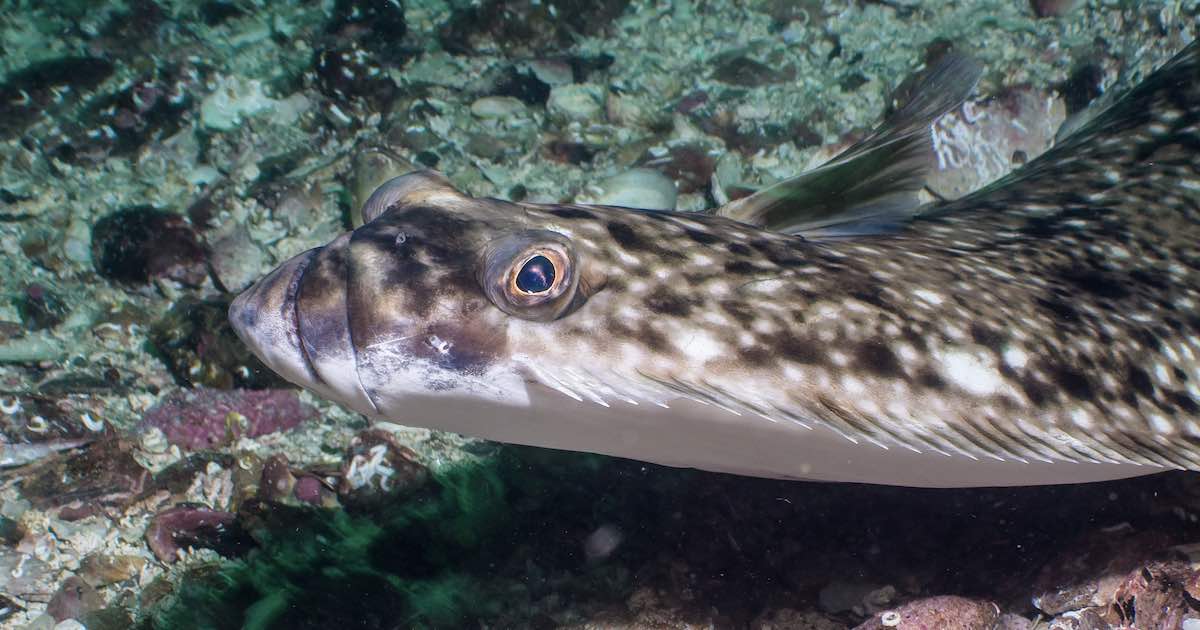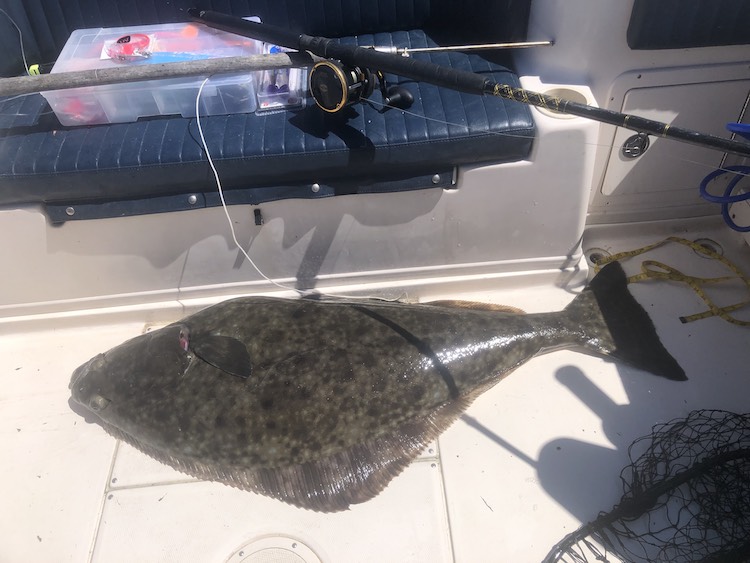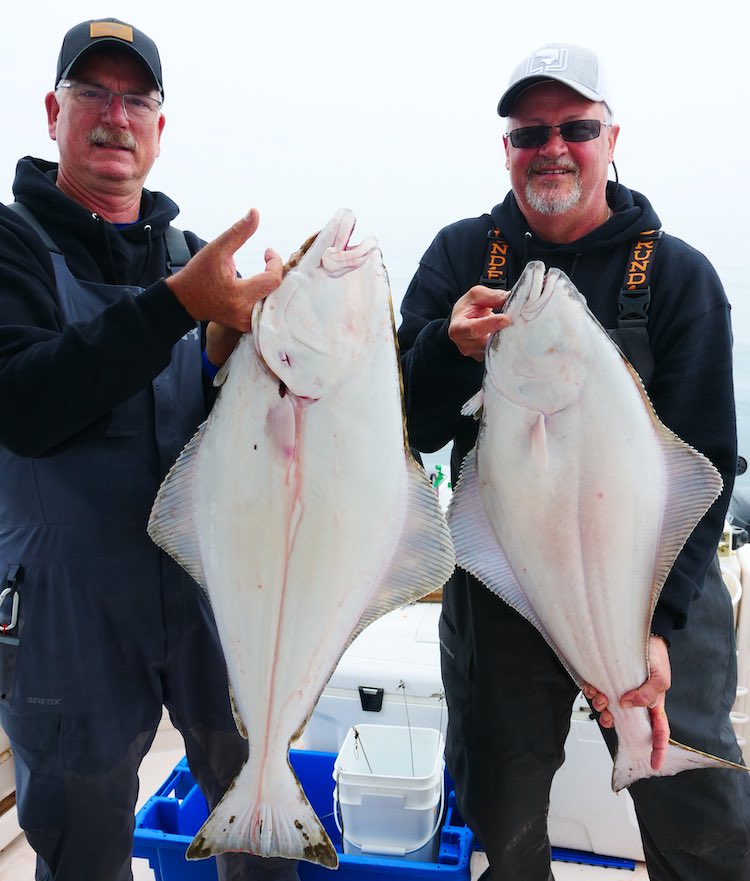
Pacific Halibut (Hippoglossus stenolepis)
- Phylum: Chordata
- Class: Telostei
- Family: Pleuronectidae
What do they look like?
Related to flounders and dabs, halibut are the largest members of the groundfish family. Our Pacific variety has a flat body in an elongated diamond shape, whose topside is camouflaged to match the sea-floor, in mottled shades of gray, black, and dark brown. Its underside is white. It has small scales that are buried in the skin, making it appear smooth and glossy. Female Pacific halibut tend to live longer and grow larger than males, but either sex can get to be huge, making them both an abundant food source and desirable trophy fish. Affectionately nicknamed “barn doors,” they sometimes grow beyond 8 ft (2.5 m) long and 5 ft (1.5 m) wide, and weigh over 500 lbs (250 kg)!

Rob Frawley – Lucky Strike Sportfishing
Where do they live?
They range throughout the north Pacific Ocean from Alaska to Baja, and Siberia to northern Japan, being most concentrated off the coasts of Alaska and British Columbia. They inhabit the sea floor in depths up to 1,000 m, with juvenile fish living in shallower waters nearer the shores, and adults generally being deeper and farther out.
How do they grow and reproduce?
Pacific Halibut spawn in winter, primarily between December and late February, in deep water along the continental slope from BC north to the Gulf of Alaska and the Bering Sea. Depending on their size, females have between 500,000 and 4 million eggs, released in batches over the course of several days during the spawning season. The time it takes them to hatch varies according to water temperature, between 12 and 20 days, after which the larvae drift around in the currents near the surface for six months to a year. By the time they are about 1.5 in (4 cm) long, they have reached their adult form and can swim down to the bottom. They remain in shallower nearshore waters for the first few years, gradually migrating deeper until they reach reproductive age, males at about 8 years of age, and females by 12 years.

Halibut harpoon
What makes them special?
Curiously, halibut larvae begin life looking symmetrical and swimming in an ordinary upright position, with an eye on each side of their heads. But during the early stages of growth, the left eye gradually migrates over the top of the head to its permanent location on the right side, which then becomes the topside. At the same time, the pigmentation of the left side fades away, and it becomes the blind underside. And ever after, halibut swim sideways.
Like many other finfish, a halibut has a button-sized calcification in its head, known as an otolith. In much the same way as a tree, this little “ear bone” accretes annual growth rings, indicating the fish’s age. The oldest Pacific halibut on record was 55 years old, but those over age 25 are not common.

Halibut on the deck
What moves them?
Halibut are powerful swimmers, capable of covering long distances, especially during the first decade of their lives. During the free-floating larvae stage, they are carried about by the counterclockwise ocean currents, often hundreds of miles. But once they attain their adult form, they nearly always migrate in a clockwise direction, moving from northwest to southeast. During their reproductive years, they also engage in seasonal spawning migrations from their shallower summer feeding grounds to their deeper winter breeding areas. In this way, halibut genetic stock mixes across the northern Pacific, resulting in only one species in this ocean.
What do they eat, what eats them, and what else kills them?
As larva, they feed on zooplankton, graduating to small crustaceans as juveniles. But when they reach adult size, these massive fish are basically at the top of the pelagic food chain. Their only predators are the occasional large shark or marine mammal, and, of course, the human being. An aggressive carnivore, the halibut will eat any creature it can fit into its prodigious mouth. A typical repast might include an appetizer of groundfish, crabs, or clams (especially geoducks); a main course of herring, cod, or sandlance; and a nice, tender octopus for dessert. Halibut will sometimes eat other, smaller halibut, and they often leave their preferred depths to hunt salmon. If opportunity presents, they have even been known to eat seal. In shallower coastal waters, they are capable of using sight and hearing to capture a meal, but in deeper waters, they rely almost entirely on their keen sense of smell. No halibut can easily resist the scent of food!

Professional Guides Pat Ahern – Last Cast Guiding & Deryk Krefting – Active Guiding halibut fishing
What are they known for? (historical/cultural references/uses)
They are best known for being delicious! Besides being an excellent source of quality protein, their meat contains high levels of inflammation-reducing omega-3 fatty acids, and immune-boosting minerals selenium and magnesium. Along with salmon, halibut have been a primary food source for natives of the Pacific Coast, for time out of mind. Traditionally, they have been smoked and dried for winter sustenance. They have been a source of commercial revenue since at least the 1880s, and they have been increasing in sport-fishing popularity for the better part of a century, now second only to Chinook salmon.
How do they survive?
On account of not having a swim bladder, halibut do not suffer from changes in water pressure. These big, strong fighters usually survive catch-and-release sport fishing as well. And, due in part to monitoring and regulation by the International Pacific Halibut Commission (a cooperative effort between Canada and the USA), their populations have been increasing steadily since 2013. So if you feel like fishing, you might as well get on out there—just for the halibut!
Visit the Store
$34.99
$34.99
Featured Catch

Joel Unickow halibut (Photo: Rob Frawley Lucky Strike Sportfishing Tofino)







